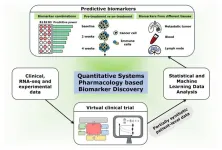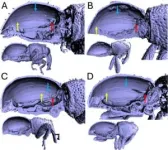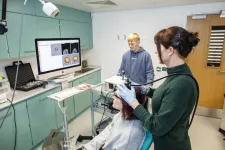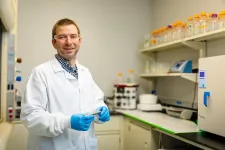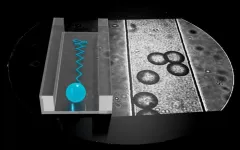(Press-News.org) FOR IMMEDIATE RELEASE
Using computational tools, researchers from the Johns Hopkins Kimmel Cancer Center and the Johns Hopkins University School of Medicine have developed a method to assess which patients with metastatic triple-negative breast cancer could benefit from immunotherapy. The work by computational scientists and clinicians was published Oct. 28 in the Proceedings of the National Academy of Sciences.
Immunotherapy is used to try to boost the body’s own immune system to attack cancer cells. However, only some patients respond to treatment, explains lead study author Theinmozhi Arulraj, Ph.D., a postdoctoral fellow at Johns Hopkins: “It’s really important that we identify those patients for whom it will work, because the toxicity of these treatments is high.”
To tease this out, studies have tested whether the presence or absence of certain cells, or the expression of various molecules in the tumor, can indicate if a particular patient will respond to immunotherapy. Such molecules are called predictive biomarkers and are useful in selecting the right treatment for patients, explains senior study author Aleksander Popel, Ph.D., a professor of biomedical engineering and oncology at the Johns Hopkins University School of Medicine.
“Unfortunately, existing predictive biomarkers have limited accuracy in identifying patients who will benefit from immunotherapy,” Popel says. “Moreover, a large-scale assessment of characteristics that predict treatment response would require the collection of tumor biopsies and blood samples from many patients and would involve performing several assays, which is very challenging.”
So, the team employed a mathematical model called quantitative systems pharmacology to generate 1,635 virtual patients with metastatic, triple-negative breast cancer and performed treatment simulations with the immunotherapy drug pembrolizumab. They then fed these data into powerful computational tools, including statistical and machine learning-based approaches, to look for biomarkers that accurately predict the treatment response. They focused on identifying which patients would and would not respond to treatment.
Using the partially synthetic data produced by the virtual clinical trial, researchers assessed the performance of 90 biomarkers alone and in double, triple and quadruple combinations. They found that measurements from tumor biopsies or blood samples taken before the start of treatment, called pretreatment biomarkers, had limited ability to predict treatment outcomes. However, measurements from patients taken after the start of treatment, called on-treatment biomarkers, were better predictive of outcomes. Surprisingly, they also found that some commonly used biomarker measurements, such as the expression of a molecule called PD-L1 and the presence of lymphocytes in the tumor, performed better when assessed before the start of treatment than after treatment initiation.
The researchers also looked at the accuracy of measurements that do not require invasive biopsies, such as immune cell counts in the blood, in predicting treatment outcomes, finding that some blood-based biomarkers performed comparably to tumor- or lymph node-based biomarkers in identifying a subset of patients who respond to treatment. This potentially suggests a less-invasive way to predict response.
Measurements of changes in tumor diameter can be readily obtained by CT scans, and also could prove predictive, Popel says: “This, measured very early within two weeks of treatment initiation, had a great potential to identify who would respond if the treatment were continued.”
To validate the findings, investigators performed a virtual clinical trial with patients selected based on change in tumor diameter at two weeks after the start of treatment. “The simulated response rates increased more than two-fold — from 11% to 25% — which is quite remarkable,” Arulraj says. “This emphasizes the potential for noninvasive biomarkers as an alternative, in cases where collecting tumor biopsy samples is not feasible.”
“Predictive biomarkers are critical as we develop optimized strategies for triple-negative breast cancer, so as to avoid overtreatment in patients expected to do well without immunotherapy, and undertreatment in those who do not respond well to immunotherapy,” adds study co-author Cesar Santa-Maria, M.D., an associate professor of oncology and breast medical oncologist at the Johns Hopkins Kimmel Cancer Center with expertise in breast cancer immunotherapy and immune biomarkers. “The complexities of the tumor microenvironment make biomarker discovery in the clinic challenging, but technologies leveraging in-silico [computer-based] modeling have the potential to capture such complexities and aid in patient selection for therapy.”
Collectively, these new findings shed light on how to better select patients with metastatic breast cancer for immunotherapy. The researchers say these findings are expected to help design future clinical studies, and this method could be replicated in other cancer types.
Previously, the team used an in-house modeling framework and developed a computational model with a special focus on late-stage breast cancer where the tumor has already spread to various parts of the body. This was published in Science Advances last year. The team employed data from several clinical and experimental studies to develop and thoroughly validate this computational model.
The current work was supported by the National Institutes of Health (grant R01CA138264). Part of the work was carried out at the Advanced Research Computing at Hopkins core facility, which is supported by the National Science Foundation under grant OAC1920103.
Study co-authors are Hanwen Wang, Atul Deshpande, Ravi Varadhan, Elizabeth Jaffee and Elana Fertig of Johns Hopkins; and Leisha Emens of Kaiser Permanente in South Sacramento, California.
Popel is a consultant to Incyte and to J&J/Janssen, and is a co-founder and consultant to AsclepiX Therapeutics. He also receives research funding from Merck. The terms of these arrangements are being managed by The Johns Hopkins University in accordance with its conflict-of-interest policies.
END
Computational tool developed to predict immunotherapy outcomes for patients with metastatic breast cancer
2024-10-29
ELSE PRESS RELEASES FROM THIS DATE:
Cerebral embolic protection by geographic region
2024-10-29
About The Study: The PROTECTED transcatheter aortic valve replacement (TAVR) trial could not show that the use of cerebral embolic protection (CEP) had a significant effect on the incidence of periprocedural stroke during TAVR. Although there was no significant interaction by geographic region, this exploratory post hoc analysis suggests a trend toward greater stroke reduction in the U.S. cohort but not in the outside the U.S. cohort. These findings are hypothesis generating, and further research is needed to determine if regional differences in patient characteristics or procedural practices ...
12 new Oriental weevil species discovered using advanced imaging tools
2024-10-29
Jake Lewis, an entomologist in the Environmental Science and Informatics Section at the Okinawa Institute of Science and Technology (OIST), is fascinated by weevils, a diverse group of beetles that includes many species with elephant trunk-like mouthparts (called a rostrum). Weevils provide various ecosystem services such as pollination and decomposition, but some species are serious pests known to decimate crop fields and timber forests.
Using x-ray microtomography, a 3D imaging technique ...
Ultrasound can be used as search and rescue tool for the brain
2024-10-29
Ultrasound, once used almost exclusively to take images of the body, is quickly developing into a targeted therapy that can have a potentially life-changing impact on our brains, according to the authors of a new article.
For decades, health professionals across the world have used ultrasound as a means of monitoring the development of unborn babies and assessing the health of patients’ internal organs.
But writing in the journal PLOS Biology, researchers from Stanford University, the University of Plymouth, and Attune Neurosciences say it has now been demonstrated to offer a non-invasive and precise way of targeting ...
Department of Defense funds study of gene therapy for muscular degeneration
2024-10-29
The U.S. Department of Defense awarded just under $514,000 to an interdisciplinary team of researchers at the U of A to study the efficacy of “self-delivering” gene editors in the treatment of Duchenne Muscular Dystrophy, or DMD.
DMD results from a mutation in the dystrophin gene and is one of the most severe inherited muscular dystrophies, leading to deterioration of the muscle fibers. Presently, there is no cure, but advances in treatment have helped patients live longer, better lives.
Gene therapy designed to ...
People’s exposure to toxic chemicals declined in the U.S. following listing under California law
2024-10-29
With growing concern about the ubiquity of toxic chemicals in consumer products, many states have passed laws aimed at protecting people from harmful substances in everyday items like cosmetics, cleaning supplies, plastics, and food packaging. California’s Proposition 65, for instance, is considered one of the most extensive toxics laws in the country.
But does the law work? According to a new study published in the journal Environmental Health Perspectives, it does.
“Not only have people’s exposures to specific toxic chemicals gone down in California, ...
Trauma, homelessness afflict gender affirming care patients at higher rates
2024-10-29
A survey of patients receiving gender affirming care shows that commercial insurance pays for most of their treatments, they receive less care in the South than other parts of the U.S. and they deal with disproportionate levels of housing insecurity and trauma compared to others, according to a new study by researchers at the Colorado School of Public Health and the University of Colorado Anschutz Medical Campus.
The study, using data provided by Kythera Labs, a healthcare clearinghouse, examined millions of insurance claims by patients undergoing gender affirming care (GA) and those not. It also looked at social determinants of healthcare (SDOH), non-medical factors ...
New $5 million DoE award supports KU startup’s green hydrogen energy research
2024-10-29
LAWRENCE — With $5 million in support from the U.S. Department of Energy, the University of Kansas and Avium — a startup firm founded by researchers from KU’s School of Engineering — aim to make clean hydrogen more affordable.
According to the DoE, the work at KU is part of $750 million in funding for 52 projects across 24 states “to dramatically reduce the cost of clean hydrogen and reinforce American leadership in the growing hydrogen industry.”
Green hydrogen is a key tool in the worldwide ...
A navigation system for microswimmers
2024-10-29
Microswimmers often need to independently navigate narrow environments like microchannels through porous media or blood vessels. The swimmers can be of biological origin, like algae or bacteria, but also constitute custom designed structures used for the transport of chemicals and drugs. In these cases, it is important to control how they swim in relation to walls and boundaries - as one might want them to exchange fuel or information, but also avoid them to stick where they are not supposed to.
Many swimmers are electrically ...
Study finds early TAVR can be beneficial for patients with asymptomatic severe aortic stenosis
2024-10-29
WASHINGTON, DC – OCTOBER 28, 2024 – The first powered randomized trial examining early intervention with transcatheter aortic valve replacement (TAVR) in patients with asymptomatic, severe aortic stenosis (AS) found this strategy to be both a safe and effective alternative to clinical surveillance (CS).
Findings were reported today at TCT 2024, the annual scientific symposium of the Cardiovascular Research Foundation (CRF). TCT is the world’s premier educational meeting specializing in interventional ...
Implantable microparticles can deliver two cancer therapies at once
2024-10-29
Patients with late-stage cancer often have to endure multiple rounds of different types of treatment, which can cause unwanted side effects and may not always help.
In hopes of expanding the treatment options for those patients, MIT researchers have designed tiny particles that can be implanted at a tumor site, where they deliver two types of therapy: heat and chemotherapy.
This approach could avoid the side effects that often occur when chemotherapy is given intravenously, and the synergistic effect of the two therapies ...
